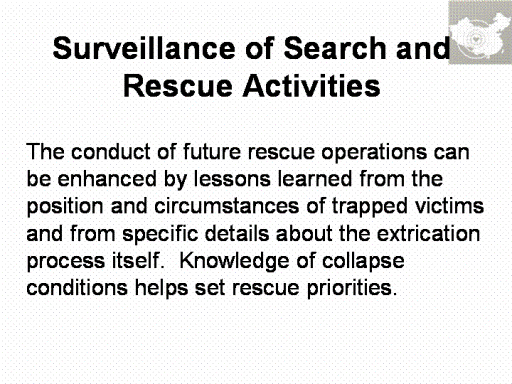| front |1 |2 |3 |4 |5 |6 |7 |8 |9 |10 |11 |12 |13 |14 |15 |16 |17 |18 |19 |20 |21 |22 |23 |24 |25 |26 |27 |28 |29 |30 |31 |32 |33 |34 |35 |36 |37 |38 |39 |40 |41 |42 |43 |44 |45 |review |
 |
For example, almost all types
of damaged buildings will contain voids or spaces in which
trapped people may remain alive for comparatively long periods of
time. To know where these
safe places may be, one needs to know the characteristics of various
types of construction.
Buildings of the same class and type of construction collapse in
much the same way, and common factors are present.
It is important that rescuers study these factors, since this
knowledge will prove helpful when extricating casualties.
Ideally, search and rescue
teams should have surveillance forms to record
important information, including the building type, the collapse
site address, the nature of the collapse, the amount of dust
present, the presence of fire or toxic hazards, the location of
victims, and the nature and severity of injuries.
Victims pronounced dead at the scene should be tagged with an
identification number so that the medical examiner's data can later
be linked to the search and rescue surveillance form.
Surveillance of search and rescue activities should be used
to direct resources to sites where the most good can be done in the
first 24-48 hours--the most critical time.
|